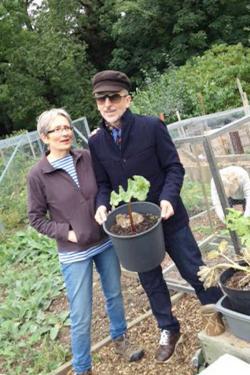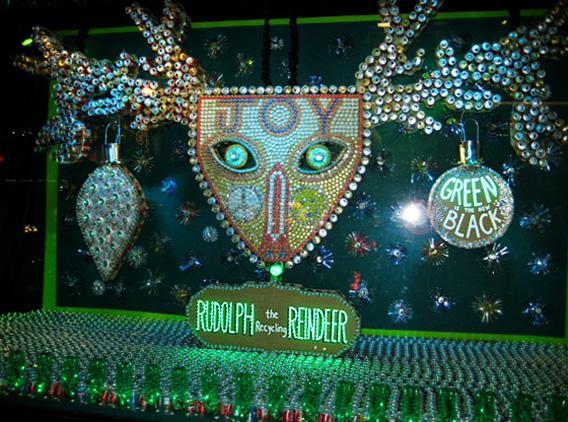When it comes to saving the planet, I am a proud, hairy-legged, organic Earth Mama, metaphorically speaking, of course. Surprised? Though many of you might think of me as a gussied-up fashion pundit, the reality is quite different. Yes, I am gussied-up, but my household products are always cruelty-free and wildly sustainable. For decades I have been using that revolting health-food store toothpaste. To mention nothing of sloshing gallons of that utterly useless Earth-friendly stuff into the dishwasher. I have even deployed one of those ineffectual rock thingies which you rub on your armpits in lieu of Right Guard.
The questionable efficacy of these products aside, the real drawback about being green is all the attendant one-upmanship. The harsh reality is that, try as one might, there is always somebody greener, poised and ready to out-crunchy one’s efforts. For a competitive person such as myself, this is a serious source of anxiety.
When Earth Day dawns, as it has today, I am invariably left with that not-so-green feeling, especially when I think of my sister. Compared with Shelagh Doonan, I am a methane-belching, Hummer-driving, cigar-chomping oligarch. How green is Sheel? She recently forced me to pee in a bucket. That bitch is dark green.
It happened during a visit to her allotment in South London. An allotment, I should explain, was once a big part of British working-class culture. Dismal tracts of unused land were allotted—for a negligible rent—to working-class Brits who used them to cultivate scurvy-repelling veggies. These community gardens are now enjoying a resurgence, beloved by organicaholics all over the British Isles.

Courtesy of Simon Doonan
While visiting my sister’s lottie on that fateful day, I drank one too many earthenware mugs of hot tea. (It was chilly and my ethically sourced foundation garments were simply not doing the trick.) Ere long I experienced the desire to pee. I was just about to nip behind a non-genetically-modified blackberry bush when sis came tearing through the undergrowth proffering a fair-trade bucket, most likely made from melted-down Enya CDs: “Don’t waste it,” she commanded, “I need it for my compost.”
As traumatizing as this incident was, it pales in comparison to what went down in 2007. This was the year that the environmental movement slashed and Al Gore’d its way into our hearts and minds … and into Barneys, my place of employ.
With a keen eye to shifting cultural mores, Julie Gilhart, the former fashion director of Barneys, threw her vegan chapeau into the ring. Before you could say “carbon-neutral pantyhose,” she had persuaded our CEO at the time, Howard Socol, that Barneys should get on board the solar-powered freedom train and go green, with a special emphasis on our holiday marketing.
Despite my commitment to mung beans and edible burlap caftans, I was completely and utterly stumped. I had designed the Barneys holiday campaign theme for more than two decades with relative ease, and yet the notion of this proposed Jolly Green Holiday was curdling my tofu.
The key to any successful holiday campaign—as Don Draper would attest—is to choose a theme that has resonant visual iconography. Previous Barneys themes included Andy Warhol—have a happy Warholiday!—and Cher, because we all know the holidays are a time for Cher-ing. These concepts were chosen because each came with a bonanza of recognizable visual associations. But green? What kind of imagery could I possibly incorporate into the gift catalog and window displays? In my mind’s eye, all I could see were drowning polar bears clutching life-preservers garlanded with tinsel.
Secondly, I, Polly Paranoia, was also concerned about potential accusations of “green-washing.” The term had recently been coined to admonish those who were exploiting the positivity of the green movement to smokescreen a more sinister agenda, or simply to sell handbags. Since most of the product sold at Barneys was nonlocal—yes, we had the occasional organic brand like Loomstate, but we harvested most of our lineup at the Paris and Milan collections and then schlepped it across the Atlantic using unimaginable amounts of jet fuel—we seemed destined to become the green-washing poster child of the new decade. My job would be to conceptualize and design it all, and then, when everything had gone all recriminatory and horrid, I would take the heat.
I made an appointment with CEO Socol in order to beg him to reconsider. Mr. Socol’s response was avuncular and direct: “Don’t get your panties in a knot. Just have fun with it.”
Fun. Laughs. Good times.
The “have fun” mandate was unexpectedly liberating. If the appropriate green iconography did not exist, then I would simply have to invent it. Sustainable Santa, Frosty the Fair-Trade Snowman. Why not? When in doubt, make tragic wordplays and drench them with alliteration.
Everything began to fall into place. The centerpiece of this festive effort was to be my finest and greenest creation: Rudolph the Recycling Reindeer. This massive sculptural assemblage would adorn the entrance of every Barneys store. Rudolph, I declared, bearing a sketch of my creation, would be constructed entirely of soda cans gathered from local recycling centers in each Barneys location. Locally harvested! Hello! Who’s green now?
The entire New York display staff journeyed down to the Bowery. These hardworking window dressers then intercepted and purchased gigantic sacks of used soda cans and plastic bottles from the cash-strapped bums as they waited on line outside the recycling center. How worthy, caring and meaningful: Not only were we re-re-recycling the cans, but we were also funding the needs—and perhaps some dodgy habits—of the homeless.
When I arrived at the display studio the next day, I was overcome by the foul odor of stinky cans. You could smell them all the way from the lobby of the building. The fragrance was hard to pin down: There was a top note of Dr. Pepper and a bottom note of rat urine, with a little stale Fresca in the middle. What would happen when we transported foul-smelling Rudolph and dumped him at the entrance of Barneys? I was too busy saving the planet to worry about it. Through a paper mask, I reassured the team that they were “doing important work” and encouraged them to head back to the Bowery for more cans, pronto.
Two days later I showed up at the studio with a network TV camera crew. They were filming a special on “the making of the Barneys windows.” The producers wanted a spontaneous opening shot. I suggested that they follow me as I flung open the studio doors to check on the progress of our monumental Rudolph. That’s when things went from green to greige.
It was a real Wizard of Oz moment: “Pay no attention to the people behind the curtain … yes, the people who are busy snapping the tops off thousands of brand new cans of soda and flushing the contents down the sink.”
The staff had OD’d on the stench and the vermin and waterbugs that accompanied the fetid Bowery-bought cans. After yet another profanity-laced interaction with a belligerent can supplier—apparently those homeless dudes were fierce negotiators—they made an executive decision and headed to Costco. See, I told you being green was nerve-racking.
Was there a green-washing backlash?
After a chilled glass of Mountain Dew and some undignified pleading from me, the TV producer agreed to discard the credibility-destroying, can-emptying footage. And so, a happy green holiday was had by all.
